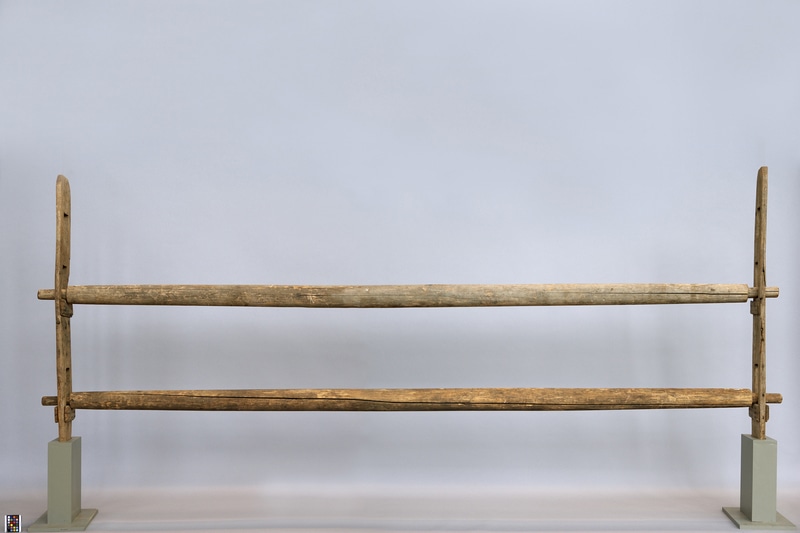Loom Item Number: A8199 from the MOA: University of British Columbia

Description
Blanket loom. The two upright side pieces (parts a-b) are relatively flat in profile, with three rectangular matching cutouts for the rollers. Small rectangular pieces are nailed beneath the lower two cutouts. The two rollers (parts c-d) are tubular and thickest in the centre. The rollers have sprockets on each end that fit into the upright cutouts.
History Of Use
Loom for weaving blankets. Traditionally, mountain goat wool blankets were worn as robes or used as bedding. The blankets were objects of status and used to compensate shamans or other specialists for their services. They were also distributed to those who witnessed weddings, naming ceremonies, and memorial rituals. The dead of wealthy families were wrapped in blankets. By the 1850s, Hudson's Bay (Company) point blankets, and other trade blankets were beginning to replace locally woven blankets.
Cultural Context
weaving; textiles
Item History
- Made in Vancouver Island, British Columbia, Canada ? before 1950
- Collected in West Saanich, British Columbia, Canada between 1950 and 1962
- Owned by Mrs. Bartleman
- Owned by Edith Bevan Cross before July 30, 1962
- Received from Edith Bevan Cross (Seller) and H. R. MacMillan (Funding source) on July 30, 1962
What
- Name
- Loom
- Identification Number
- A8199
- Type of Item
- loom
- Material
- wood and metal
- Manufacturing Technique
- carved and nailed
- Part A
- height 136.0 cm, width 17.0 cm, depth 7.5 cm
- Part B
- height 135.0 cm, width 17.5 cm, depth 7.5 cm
- Part C
- height 376.5 cm, diameter 17.25 cm
- Part D
- height 376.0 cm, diameter 18.5 cm
- Overall
- height 136.0 cm, width 376.5 cm, depth 17.5 cm
Who
- Culture
- Coast Salish: Saanich
- Previous Owner
- Mrs. Bartleman and Edith Bevan Cross
- Received from
- Edith Bevan Cross (Seller) and H. R. MacMillan (Funding source)
Where
- Holding Institution
- MOA: University of British Columbia
- Made in
- Vancouver Island, British Columbia, Canada ?
- Collected in
- West Saanich, British Columbia, Canada
When
- Creation Date
- before 1950
- Collection Date
- between 1950 and 1962
- Ownership Date
- before July 30, 1962
- Acquisition Date
- on July 30, 1962
Other
- Condition
- good
- Current Location
- Case 2
- Accession Number
- 0081/0134